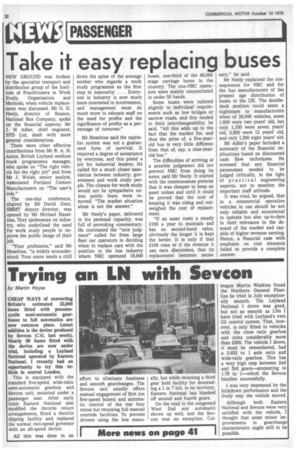Laze PASSENGER
Page 34

If you've noticed an error in this article please click here to report it so we can fix it.
Take it
easy replacing sarbeu s e s buses, one-third of the 48,000 NEW GROUND was broken by the specialist transport and distribution group of the Institute of Practitioners in Work Study, Organisation and Methods, when vehicle replacement was discussed. Mr G. D. Neely, director of finance, National Bus Company, spoke on the financial aspects; Mr J. H Adler, chief engineer, SPD Ltd, dealt with more general considerations.
There were other effective contributions from Mr R. A. H. Aston, British Leyland medium truck programmes manager, who spoke on "The right vehicle for the right job" and from Mr J. Welsh, senior analyst, Associated Portland Cement Manufacturers on "The user's role."
The one-day conference, chaired by Mr David Gent, SIVIMT deputy director, was opened by Mr Michael Haseltine, Tory spokesman on industry, who underlined the need for work study people to improve the public image of their job.
"Your profession," said Mr HeseRine, "is widely misunderstood. Your name sends a chill down the spine of the average worker who regards a work study programme as the first step to insecurity. . . . Everyone in industry is now much more interested in involvement, and management must do much more to educate staff on the need for profits and the significance of profits as a percentage of turnover."
Mr Heseltine said the capitalist system was not a guaranteed form of survival. It required a degree of acceptance by everyone, and this posed a job for industrial leaders. He called for a much closer association between industry, government and work study people. The climate for work study would not be sympathetic unless public fears were removed. "The market situation alone is not the answer."
Mr Neely's paper, delivered in his personal capacity, was full of provoking commentary. He contrasted the "nice judgment" called for from large fleet car operators in deciding when to replace cars with the position in the bus industry where NBC operated 16,000 buses, one-third of the 48,000 stage carriage buses in the country. The non-NBC operators were mainly concentrated in under 50 hands.
Some buses were tailored slightly to individual requirements such as low bridges or narrow roads, and this tended to limit interchangeability, he said. "All this adds up to the fact that the market for, and thus the price of, a five-yearold bus is very little different from that of, say, a nine-yearold bus."
The difficulties of arriving at a sensible judgement did not prevent NBC from doing its sums, said Mr Neely. It started with the commonsense premise that it was cheaper to keep an asset unless and until it could be proved that the cost of keeping it was rising and outweighed the cost of replacement.
"If an asset costs a steady £100 a year to maintain and has no second-hand value, obviously the longer it is kept the better. It is only if that £100 rises or if the revenue it can earn diminishes, that its replacement becomes neces Mr Neely explained the consequences for NBC and for the bus manufacturers of the present age distribution of buses in the UK. The doubledeck position could seem a nightmare to manufacturers when of 28,000 vehicles, some 1,800 were two years' old, but only 1,100 were seven years' old, 2,500 were 12 years' old, and only 1,300 eight years' old.
Mr Adler's paper included a summary of the financial implications based on discounted cash flow techniques. He stressed that any financial parameters needed to be judged critically, in the light of practical engineering aspects, not to mention the important staff attitude.
It was vital, he argued, that in a commercial operation vehicles in use should be not only reliable and economical to operate but also up-to-date in their relevance to the demand of the market and capable of higher revenue earning. Hence, a financial case with emphasis on cost elements failed to provide a complete answer.




































































































































